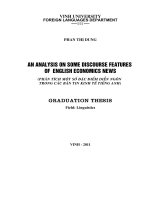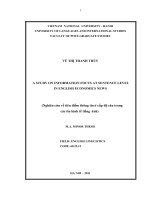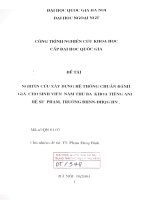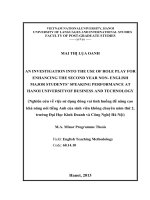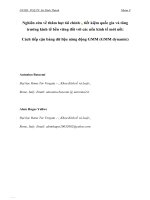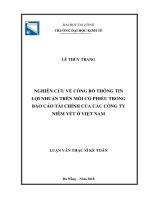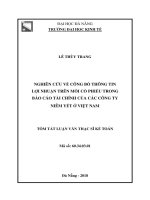Nghiên cứu về tiêu điểm thông tin ở cấp độ câu trong các tin kinh tế tiếng Anh
Bạn đang xem bản rút gọn của tài liệu. Xem và tải ngay bản đầy đủ của tài liệu tại đây (1.02 MB, 61 trang )
1
VIETNAM NATIONAL UNIVERSITY - HANOI
UNIVERSITY OF LANGUAGES AND INTERNATIONAL STUDIES
FACULTY OF POST-GRADUATE STUDIES
VŨ THỊ THANH THÚY
A STUDY ON INFORMATION FOCUS AT SENTENCE LEVEL
IN ENGLISH ECONOMICS NEWS
(Nghiên cứu về tiêu điểm thông tin ở cấp độ câu trong
các tin kinh tế tiếng Anh)
M.A. MINOR THESIS
FIELD: ENGLISH LINGUISTICS
CODE: 60.22.15
HA NOI – 2011
2
VIETNAM NATIONAL UNIVERSITY - HANOI
UNIVERSITY OF LANGUAGES AND INTERNATIONAL STUDIES
FACULTY OF POST-GRADUATE STUDIES
VŨ THỊ THANH THÚY
A STUDY ON INFORMATION FOCUS AT SENTENCE LEVEL
IN ENGLISH ECONOMICS NEWS
(Nghiên cứu về tiêu điểm thông tin ở cấp độ câu trong
các tin kinh tế tiếng Anh)
M.A. MINOR THESIS
FIELD: ENGLISH LINGUISTICS
CODE: 60.22.15
SUPERVISOR: Assoc.Prof. VÕ ĐẠI QUANG (PhD)
HA NOI - 2011
5
LIST OF TABLES AND FIGURES
Table 1: Marked and Unmarked Theme
Table 2: Syntactic Strategies in Assigning Information Focus
Table 3: Frequency of Occurrence and Percentage of Contribution of Some Grammatical
Devices of End-Focus Strategy in English Economic News
Table 4: Frequency of Occurrence and Percentage of Contribution of the Active and
Passive in English Economic News
Table 5: Frequency of Occurrence and Percentage of Contribution of Sub-categories of
Passivization in English Economic News
Figure 1: Construction of the Existential strategy
Figure 2: Construction of Extrapotition of Finite Subject Clause
Figure 3: Construction of Thematic Fronting
6
ABBREVIATIONS
A: Adverbial
C: Complement
Cl: Clause
ESP: English for special purpose
NG: Nominal group
O: Object
S: Subject
V: Verb
7
TABLE OF CONTENT
Acknowledgements i
Abstract ii
List of tables and figures iii
Abbreviations iv
Table of content v
CHAPTER ONE: INTRODUCTION
1.1. Rationale of the Study 1
1.2. Scope of the Study 2
1.3. Objectives of the Study 2
1.4. Method of the Study 2
1.5. Design of the Study 3
CHAPTER TWO: THEORETICAL BACKGROUND
2.1. The Concept of Discourse 5
2.2. Discourse and Text 6
2.3. Spoken and Written Discourse 7
2.4. Thematic Structure 8
2.5. Information Structure 11
2.5.1. The Notion of Information Structure 11
2.5.2. Information Focus 13
2.5.3. Principle of End-Focus 14
2.5.4. Principle of End-Weight 15
2.6. Economic News Discourse 16
CHAPTER THREE: INFORMATION FOCUS IN ENGLISH ECONOMICS NEWS
3.1. Marked and Unmarked Theme 17
3.2. Syntactic Strategies in Assigning Information Focus 19
3.2.1. End-Focus Strategy 20
8
3.2.1.1. The Active- Passive Alternative 21
3.2.1.1.1. The Active 21
3.2.1.1.2. The Passive 23
3.2.1.2. Existential 27
3.2.1.3. Extraposition 29
3.2.2. Thematisation Strategy 30
CHAPTER FOUR: PEDAGOGICAL IMPLICATIONS
4.1. Findings from the Interviews 33
4.2. Pedagogical Implications 34
4.3. Suggested Types of Exercises 34
CHAPTER FIVE: CONCLUSIONS
5.1. Concluding Remarks 37
5.1.1. Conclusion on Objective One 37
5.1.2. Conclusion on Objective Two 38
5.2. Recommendations for Further Studies 38
References 39
Appendices
9
CHAPTER ONE: INTRODUCTION
1.1. Rationale of the Study
It is common knowledge that language is a means of communication and has
always mirrored society. It is English that is one of the most common languages and is
being used all over the world in education, business, science, technology.etc. The
economic development of our world recently has given rise to the development of
economics literature, including books, magazines, newspapers and journals. Therefore,
it is clear that English is needed for economic communication not only in spoken but
also in written form.
There are messages exchanging in each communication. Any message is the result
of number choices made by sender, though it has to be said that these choices are to
some extent determined by the context of the message- who the receivers are, what the
purpose of the message is. According to Leech (1975), there are three conditions that
make a message to be understood, such as the message has to be cut up into individual
pieces of information, the ideas have to be given the right emphasis, and the ideas have
to be put in the right order.
Accordingly, it is the speaker and the writer who decide how to understand the
messages. While speakers can directly convey their information focus through stress
and pitch, the writer must construct a clause, indeed the whole sentence (and text),
carefully — with judicious word order, punctuation, and discourse implication (about
what the writer considers given or new information for the audience) — to recapture
the loss of such explicit markers of emphasis in speech. In written English, therefore,
the reader has to rely on the structure and ordering of the syntax. It can be seen that
each derivation of the basic English sentence pattern SVO has its own emphasis on
different sentence elements. Studying the derivation patterns makes clear contribution
to the understanding of how the message is organized and the proper understanding of
the message.
From the author‘s teaching experience and the common problems faced by students
of economics, Vietnamese learners have some difficulties in realizing the information
focus of individual clause or sentence. This happens as they do not obtain how the
10
focus of information assigned in different sentence patterns. As a result, they meet
certain obstacles in understanding the controlling idea of the whole passage or in
writing interesting passages.
All the reasons mentioned above have inspired the author to conduct this study.
Studying and analyzing economic news discourse attracts the author‘s attention
because economics news is one of the highest interests of readers all over the world in
general and Vietnamese ones in particulars. Hopefully, the study will make some
useful contribution to the way the readers analyze and understand properly how the
message is organized and the information focus of each message.
1.2. Scope of the Study
There are various types of economics discourse which may come from textbooks,
newspapers, magazine, reports or journals. However, this study does not explore all the
mentioned economics discourse. The writer will only focus on written English
economic news discourse taken from some mainstream newspapers. Within the
framework of a minor M.A thesis, the present study will just take up syntactic devices
employed in assigning information focus at sentence level in the light of discourse.
Furthermore, the investigation is carried out in the English language only. It is hoped
that this study will help the readers in general and teachers and students in particular to
gain an insight into the information focus of English economic news.
1.3. Objectives of the Study
The inter-related objectives of this thesis are:
(i) To give a systematic and comprehensive description of syntactic devices
employed for assigning information focus in English economics news.
(ii) To propose possible implications for teaching students how to assign
information focus.
1.4. Method of the Study
The study is confined to the syntactic strategies in assigning information focus in
English economics news. The result should be useful for language teaching and
11
learning. In order to achieve the objectives as stated above, research methods of
description, analysis, statistics in linguistics and survey have been used.
Firstly, ten pieces of English economic news written by different journalists will be
carefully selected from mainstream newspapers written in English including
Economics, The Times, Times online, The Sunday Times, Global Finance, CNN, etc.
Secondly, all syntactic features in assigning information focus in these news
discourses are picked up. The percentages and frequencies of various types of syntactic
strategies are calculated. However, only outstanding examples are used to illustrate.
Finally, after analyzing and systematizing syntactic strategies employed in the
English economics news, the author will carry out interviewing the third-year students
of economics major. Based on the interviews, some implications in teaching English
will be figured out.
1.5. Design of the Study
The thesis consists of five chapters:
Chapter one of this study is an introduction presenting some background
information and the rationale of the study. The objectives, the scope and method of the
study are also dealt with in this chapter.
Chapter two is aimed to present the theoretical background of the work. Some
essential concepts closely related to the study are carefully discussed one by one.
Firstly, some theories of discourse including the concept of discourse, discourse and
text, spoken and written discourse. Next, thematic structure and information structure
are taken into consideration. In term of information structure, the notion of information
structure, information focus, principle of end-focus and principle of end-weight are
presented. Finally, some features of economic news discourse are also discussed in the
chapter.
Chapter three attempts to analyze English economics news in the light of
Discourse Analysis. In this chapter, the marked and unmarked themes, and syntactic
strategies in assigning information focus are investigated. The frequency of occurrence
and the percentage of contribution of each strategy are clarified.
12
Chapter four is concerned with findings from the interviews of third year
students of Economics major at Thai Nguyen University. Based on these findings,
some useful pedagogical implications and some suggested types of exercises are
delivered.
The last chapter is set up to give concluding remarks on the two objectives of
the thesis and gives suggestions for further research.
13
CHAPTER TWO: THEORETICAL BACKGROUND
In this chapter, the author is going to talk about preliminaries that are employed to
conduct the investigation into information focus at sentence level in English economics
news.
2.1. The Concept of Discourse
Traditionally, language was viewed as a biologically determined phenomenon and
its social aspect was neglected. Language study, therefore, has based on isolated
sentences. However, it is more important to produce and understand meaningful
language than to produce and recognize grammatically correct sentences. According to
Cook (1989), not all sentences are interesting, relevant or suitable; one cannot just put
any sentence one after another and hope that it will mean something. It is not always
true that grammatically correct sentences are meaningful. While, although people
communicate with correctly complete sentences, they are still make their
communication understandable and successful. It cannot be denied that language must
be learnt and comprehended in its social context. Consequently, the concept of
discourse came into being and has been a rapidly expanding field of linguistic study.
There have been lots of observations on discourse by many linguists and each of
them has their own ways to define discourse. Richards (1985) uses the term discourse
to refer to language use or language in use. Brown and Yule (1983:18) pointed out that
―discourse is language material, either spoken or written, in actual uses by speakers
(and writers) of the language.‖ Cook and Crystal share the similar perspective of
discourse. Cook (1989) considered discourse as ―stretches of language perceived to be
meaningful, unified, and purposive‖. Crystal (1992) defined discourse as "a continuous
stretch of (especially spoken) language larger than a sentence, often constituting a
coherent unit such as a sermon, argument, joke, or narrative.‖ However, Widdowson
(1997) defines discourse as a use of sentences to perform acts of communication which
cohere into larger units.
Obviously, a discourse is a unit of meaning and it is the language that is functional.
14
As Cook (1989) stated, ―discourse is the language in use for communicating, even
though it is an interpersonal or non-personal communicative‖. Within the limit of this
paper, we would like to take an idea from Nunan (1993) that discourse is
communicative events involving language in context.
Language used in economic news is discourse because it is the language in use for
the purpose of communication.
2.2. Discourse and Text
There has been a lot of confusion between the two terms discourse and text, which
has been causing a pitfall for discourse analysis.
There are some linguists who share the same idea that these two terms can be used
interchangeably. According to Halliday & Hasan (1989:10) ―text (discourse) can be
defined in the simplest way perhaps by saying that it is language that is functional. By
functional we simply mean language that is doing some job in some context as apposed
in isolated words or sentences that I might put on the blackboard. (These might also be
functional of course if I was using them as linguistic examples). So any living language
that is playing some part in a context of situation, we shall call a text. It may be either
spoken or written or indeed in other medium of expression that we like to think of.‖
Moreover, Halliday & Hasan (1976:1) found no distinction between them when they
stated ―a text may be spoken or written, pose or verse, dialogue or monologue.‖
On the other hand, some other linguists draw a clear and explicit distinction
between the two terms. Brown and Yule (1983:6) claims that ―discourse is language
material, either spoken or written, in actual uses by speakers (and writers) of the
language.‖ while text is ―the representation of discourse and the verbal record of
communicative act.‖ From his point of view, Crystal (1992) states ―discourse is a
continuous stretch of (especially spoken) language larger than a sentence, often
constituting a coherent unit, such as sermon, argument, joke or narrative‖ while text is
―a piece of naturally occurring spoken, written, or signed discourse identified for
purposes of analysis. It is often a language unit with a definable communicative function,
such as a conversation, a poster.‖ According to Cook (1989: 156), discourse is
considered as ―stretches of language perceived to be meaningful, unified, and
15
purposive‖ whereas text is ―a stretch of language interpreted formally, without
context.‖ It is clear that these linguists see discourse as a process and text as its product.
For the sake of the study, the writer of this thesis would take the viewpoint that it
is sometimes impossible to make a clear distinction between discourse and text. This
study will follow the trend that two terms can be used interchangeably. In particularly,
it follows the approach developed by Halliday and Hasan. The term ―text‖ is used to
refer any written record of communication event and regarded as the product of
discourse.
2.3. Spoken and Written Discourse
Spoken and written languages present different modes of expressing language
meanings. According to Halliday (1985), ―Written language does, in fact, perform a
similar range of broad functions to those performed by spoken language- that is, it is
used to get things done, to provide information and to entertain‖. David Nunan (1993)
also shared the same idea when he pointed that ―the differences between spoken and
written modes are not absolute, and the characteristics that we tend to associate with
written language can sometimes occur in spoken language and vice versa‖. Do Huu
Chau (1996) also confirms the interrelation between spoken and written discourse.
Accordingly, written discourse can be represented inform of spoken discourse and vice
versa. For example, lectures, speeches are written discourse made to be spoken. On the
other hand, from the point of view of some other linguists, in discourse analysis we
need to distinguish between spoken and written language because each mode seems to
possess different features.
It is considered that spoken discourse is less formal, less planned and orderly,
more open to intervention by the receiver. Halliday (1985) stated ―speaking does not
show clearly sentence and paragraph boundaries or signal the move into direct
quotation‖. He also pointed out that ―talking might be spontaneous which results in
mistakes, repetition, sometimes less coherent sentences where even grunts, stutters or
pauses might be meaningful.‖ This view is based on the perception that speech
depends on a shared situation and background for interpretation whereas writing does
not depend on such a shared context. Additionally, in spoken discourse, content words
16
tend to be spread out over a number of clauses rather than being tightly packed into
individual clauses which is more typical of written discourse. Another feature of
spoken discourse is it may consist of nonsense vocabulary, slang, or contracted forms
(I‘ll, you‘re, he‘s…). Rhythm, intonation and speed of utterance are other important
features of oral discourse. (Crystal 1992:291).
On the contrary, written discourse is considered as more structurally complex and
elaborate than speech. According to Crystal (1995:291) ―writing develops in space in
that it needs a means to carry the information. The writer is frequently able to consider
the content of his work for almost unlimited period of time which makes it more
coherent, having complex syntax and ―the reader might not instantly respond to the
text, ask for clarification, hence neat message organization, division to paragraphs,
layouts are of vital importance to make comprehension easier.‖ In addition, according
to Halliday written discourse tends to be more lexically dense than spoken discourse.
Lexically density refers to the ration of content words to grammatical or function
words within a clause. Content words include nouns and verbs while grammatical
words include items such as prepositions, pronouns and articles.‖
2.4. Thematic structure
The thematic structure is a formal category in the analysis of sentences and clauses.
In this structure, one element called Theme serves as the departure point of the
message, which in English coincides with the initial element of the clause. This then
combines with the remainder called Rheme.
There has been a variety of definition of Theme by different linguists. According to
Nunan (1993) theme is a formal grammatical category which refers to the initial
element in a clause. It is the element around which the sentence is organized and the
one to which the writer wishes to give prominence. A Czech linguist named Mathesuis
defines theme as ―that which is known or, at least obvious in the given situation and
from which the speaker precedes in his discourse‖. The initial constituent of a clause
serves as "the point of departure for the clause as message" (Halliday, 1967) or as the
"starting point" from which readers interpret the message of the clause (Halliday, 1985;
MacWhinney, 1977; Quirk, Greenbaum, Leech, & Svartvik, 1985).
17
The theme organizes the clause as message, functioning as the starting point of the
message. In English, the theme is realized by the element in clause initial position.
Halliday (1970) characterizes the thematic constituent as the ―peg on which the
message of the clause is hung‖. According to Brown et al (1983), Theme has two main
functions such as: connecting back and linking into the previous discourse, maintaining
a coherent point of view and serving as a point of departure for the further development
of the discourse. A theme may be realized by a nominal group, a prepositional phrase,
an adverbial group, or even a clause in the case of predicated theme. In speaking or
writing, we signal that an item has thematic status by putting it first.
With regard to the three-dimensional metafunctional structure of the clause, themes
can be identified in three different types namely topical, interpersonal and textual in
the realization of the three types of clause elements. A topical theme has to do with the
information conveyed in the discourse. An interpersonal theme is any combination of a
modal theme consisting of a modal adjunct, vocative element (any item used to
address) and a mood-making element (a finite verbal operator, or WH-interrogative or
imperative Let’s.). A textual theme links a clause to the rest of the discourse.
The following is an example of Theme-Rheme structure:
Unfortunately,
Not surprisingly,
however,
then,
the “Un-artist”
its operations
proliferated within the art institutions
as well.
were viewed with admiration.
Interpersonal
textual
experiential
Rheme
Theme
(Thompson Geoff, 1996:137)
It is necessary to distinguish between the terms Theme-Rheme and Given-New.
From his point of view, Halliday considers that Theme-Rheme and Given-New are not
the same. He states:
18
―The Theme is what I, the speaker, choose to take as my point of departure. The
given is what you, the listener already knows, or has accessible to you. Theme-Rheme
is speaker oriented, while Given-New is listener oriented‖
(Halliday, 1985: 278)
Theme, which is considered as ―point of departure‖ on the message, always
appears before Rheme in the clause.
E.g.
The duke
Once upon a time
Who
Has given my aunt that teapot.
There were three bears.
Killed Cock Robin?
Theme
Rheme
(Halliday, M. A. K, 1985)
Nunan (1993) states that one important consideration is whether the information
has already been introduced into the discourse, or is assumed to be known to the reader
or listener. Such information is referred to as given information. It contrasts with
information which is introduced for the first time and which is known as new
information. In contrast to Theme-Rheme, Given-New does not always appear in the
same order.
E.g.
A. We flew to Paris on a Jumbo JET.
B. No, it was to ROME that we
flew on a Jumbo.
New
Given
B. No, it was on a Jumbo
that we flew to ROME.
Given
New
(Downing et al., 1992)
In the consideration of the system of markedness, themes are divided into two
types, namely unmarked and marked themes. The unmarked theme of a clause, which
19
is generally understood as ―usual and most typical‖, is a subject in a statement, an
operator in a Yes/No question, Wh-element in a Wh-question and main verb in a
command.
E.g.
Alice
Did
Where
Go
Let’s
went home.
Alice go home?
did Alice go?
home!
go home!
Unmarked Theme
Rheme
(Downing et al., 1992: 227)
Marked theme is considered ‗untypical or unusual‘. In relation to the system of
mood, a theme is called unmarked when it conflates with the Mood structure
constituent that typically occurs in the first position in the clause. For example, in
declarative clauses, an unmarked theme is a constituent that conflates with the Subject,
while a marked theme is the one functioning as some element of the Residue such as
Complement, Adjunct, or Predicator. Here are some examples:
Once upon a time,
Very carefully
With sobs and tears
there were three bears.
she put him back on his feet again.
he sorted out those of the largest size.
Marked Theme
Rheme
(Halliday M A K, 1985)
2.5. Information Structure
2.5.1. The Notion of Information Structure
The term information structure (IS) goes back to Halliday (1967) and has been
widely used in the subsequent literature to refer to the partitioning of sentences into
20
categories such as focus, background, topic, comment etc. There is no con- sensus on
what and how many categories of information structure should be distinguished, or
how these can be identified.
There has been disagreement and confusion about Information Structure.
An extremely important aspect of functional grammar is the way information is
structured in communication. Whenever we explain something to someone in both
speech and writing, we instinctively try to organize what we say or write in a way that
will make it easier for the hearer or reader to understand.
In his book ―Information Structure and Sentence Form‖, Lambrecht stated that
―Even though information structure is concerned with such psychological phenomina
as the speaker‘s hypotheses about the hearer‘s mental states, such phenomena are
relevant to the linguist only in as much as they are reflected in Gramatical Structure
(morphosyntax, prosody). The importance of this caveat cannot be overemphasized. I
take information structure to be a component of Grammar, more specifically of
SENTENCE GRAMMAR,i.e. I take it to be a determining factor in the formal
structuring of sentences.‖ Brown, Gillian and Yule, George (1993) share some similar
ideas that information structure is realized partly by syntax (i.e.the word order) and
partly by phonological prominence and pause.
On the idea of Halliday about the organization of information, it is phonological
realisation, especially to intonation. According to Richards (1985), Information
Structure is defined more broadly. It is the use of word order, intonation, stress and
other devices to indicate how the message expressed by a sentence is to be understood.
Nunan (1993: 120) stated that Information Structure is the ordering of elements within
sentences and utterances according to assumptions about the current state of knowledge
of the listener and reader, and elements which the speaker or writer wishes to
thematize.
"There is a close semantic relationship between information structure and thematic
structure. Other things being equal, a speaker will choose the Theme from within what
is Given and locate the focus, the climax of the New, somewhere in the Rheme"
(Halliday, 1985, p. 278).
In this study, an investigation is put on English economics news which is in the
21
form of written discourse. Therefore, there is no consideration on phonological
realization of the organization of information. Syntactic features are the only
motivation for the author.
2.5.2. Information Focus
In his book ―Functional Grammar‖, Halliday stated that ―Each information unit is
realized as a pitch contour, or TONE, which may be falling, rising or mixed. This pitch
contour extends over the whole tone group. Within the tone group, one foot (and in
particular its first syllable) carries the main pitch movement: the main fall, or rise, or
the change of direction. This feature is known as TONIC PROMINENCE, and the
element having this prominence is the TONIC element (tonic foot, tonic syllable)…The
element having this prominence is said to be carrying INFORMATION FOCUS‖. The
term focus refers to a cross-linguistic semantic phenomenon related to the highlighting
of information for communicative purposes. In English, focus is typically connected to
words in an utterance that are perceived by hearers as stressed or emphasized by
speakers. Such syllables can be louder or longer than the syllables around them.
It is implied in Bolinger‘s early definition of what he calls the ―information point‖
of a sentence:
―We can say that the prosodic stress…marks the ―point‖ of the sentence, where
there is the greatest concentration of information, that which the hearer would be least
likely to infer without being told. (1954:152)‖
More explicitly, the notion of focus according to Halliday (1976), ―information
focus is one kind of emphasis, that whereby the speaker marks out a part (which may
be the whole) of a message block as that which he wishes to be interpreted as
informative. What is focal is ―new‖ information; not in the sense that it cannot have
been previously mentioned, although it is often the case that it has not been, but in the
sense that speaker presents it as not being recoverable from the preceding
discourse…the focus of the message, it is suggested, is that which is represented by the
speaker as being new, textually (and situationally) non-derivable
In spoken English, information focus is achieved by manipulating intonational contours
so that informationally important elements receive nuclear stress in tone units. Since
22
those tone units can be conveyed directly, this creates few problems. In written
English, however, the reader has to rely more heavily on linear ordering of the syntax.
While speakers can directly convey their emphases through stress and pitch, the writer
must construct a clause, indeed the whole sentence (and text), carefully — with
judicious word order, punctuation, and discourse implication (about what the writer
considers given or new information for the audience).
Within the scope of the study, only written English Economic News discourse is
focused. Therefore, syntactic features are taken into consideration.
2.5.3. Principle of End-Focus
One strategy for interpreting the focus of information from syntax is the principle of
end-focus (Quirk, Greenbaum, Leech, & Svartvik, 1985, p. 1356-57). There is a
variation in the information value of different parts of a clause or a sentence. It is
normal to arrange the information in our message so that the most important
information comes at the end. The clause-final element carries the (relatively) highest
information emphasis, or ―end-focus‖ as Quirk, Greenbaum, Leech and Svartvik (1985)
put it: ―…it is common to process information in a message so as to achieve a linear
presentation from low to high information value. We shall refer to this as the principle
of END-FOCUS‖. Leech et al (1975) also recognized that a sentence is generally more
effective if the main point is saved up to the end. In contrast, the beginning of a
sentence or clause typically contains information that is general knowledge, or is
obvious from the context, or may be assumed as given because it has been mentioned
earlier. For example:
- It is unbelievable how much that child eats.
It can be seen that the subject clause in the above example carry new information.
They are longer and much informative than their complement.
If the following clause is kept in the first front position, it sounds marked and less
natural.
- That people demonstrate against war surprises no-one.
It is normally write in this way:
23
- It surprises no-one that people demonstrate against war.
2.5.4. The principle of End-Weight
Where there is a choice, it is normal to put long and complex constituents at the
end of a sentence or clause. This principle of end-weight is in large part a consequence
of the principle of end-focus, since the more important information tends to be given in
fuller detail. The ―weight‖ of an element can be defined in terms of length or in term of
grammatical complexity.
It is more difficult to understand a sentence when the subject is considerably longer
than the predicate. We can rephrase the sentence to shift the weight to the end:
Consider the following examples:
1. (a) That he did not understand what I said at the lecture is very strange!
(b) It is very strange that he did not understand what I said at the lecture.
2. (a) The rate at which the American people are using up the world‘s supply of
irreplaceable fossil fuels and their refusal to admit that the supply is limited is
the real problem.
(b) The real problem is the rate at which the American people are using up the
world‘s supply of irreplaceable fossil fuels and their refusal to admit that the
supply is limited.
It is clear, for communicative purposes, that 1(b) and 2(b) are more appropriate
than 1(a) and 2(a), since the former has a long, complex phrase in subject position, and
that may make it difficult to interpret.
The principle of end-weight, as (Greenbaum 1991) mentions, usually has a strong
relationship with the principle of end-focus, in which the most significant information
is likely to occur at the end of the clause. However, the two principles can conflict, as
can be seen in the examples below:
(a) My father owns the largest betting-shop in London.
(b) The largest betting-shop in London belongs to my father.
(Leech, 1975)
Leech and Svartvik (1975) note that in (a), the long object phrase comes after the
short subject ‗my father‘, to respect the principle of end-weight. In contrast, this
24
principle is broken by putting the long phrase in (b) in the theme position; but it could
be said that the writer did so to apply the principle of end-focus to ‗my father‘.
Therefore, in this situation, the two principles of end-focus and end-weight conflict.
2.6. Economic News Discourse
Language of Economics has a distinctive function of language. As Halliday‘s point
of view, economics is a generalized functional variety of modern English language. It
varies greatly in rhetorical functions such as expository, analytic, synthetic, and
informing. Economics news is one type of press. According to Nguyễn Thị Vân Đông
(2001), the function of press is ―informing and provoking reader‘s curiosity and
satisfying their choice.‖
In this thesis, the mode of economic news is in the form of written language, thus it
has several characteristics:
The use of normalization, metaphor, personification, syntactic features like the
passive and the leavings of gaps in message are used to make economics writing
what it is.
Terminology is the most important part of vocabulary in scientific prose, in
particular and in economics discourse in particular.
The language of economic news must be concise and clear; the content is up to date
and excites the readers‘ curiousness.
The descriptive sentences with a concise structure are mainly used instead of
multi-clause sentences.
In economics discourse, reference made to the relationships of factors is often
represented through graphs, tables and charts.
25
CHAPTER THREE: INFORMATION FOCUS IN ENGLISH
ECONOMICS NEWS
3.1. Marked and Unmarked Theme
Theme is a meaningful choice, as in other parts of the grammar, writers can choose
between a marked and an unmarked option. Unmarked theme is generally understood
as ‗usual and most typical‘ while marked considered ‗untypical or unusual‘. In relation
to the system of mood, a theme is called unmarked when it conflates with the Mood
structure constituent that typically occurs in the first position in the clause. For
example, in declarative clauses, the unmarked theme takes place when a theme
coincides with the clause subject. In this case, Theme typically contains familiar, old
or given information. Theme provides the settings for the remainder of the sentence –
Rheme. Rheme is the remainder of the message in a clause in which Theme is
developed, that is to say, Rheme typically contains unfamiliar or new information,
therefore, receiving the information focus.
Here are some examples from exploited news discourse:
Unmarked themes:
1. It was the 12
th
gain in 13 months
(Timesonline, March 9, 2011)
2. Senate leadership expects the Senate to take up the bill later this week.
(Timesonline, July 13, 2010)
3. Eurozone's €440 billion sovereign rescue fund will be operational by the
end of month
(Timesonline, July 14, 2010)
4. The National Institute of Economic and Social Research (NIESR)
calculated that GDP grew by 0.4 per cent in the first quarter, matching
growth in the final three months of last year as the country emerged from
the longest recession on record.
(The Times, April 9, 2010)
26
5. We need to unleash the full potential of the service sector and find new
areas-green and digital technologies, for instance-that can fill the gap.
(Global Finance, January 2010)
On the other hand, marked sentences often contain a Theme that is separate from
the subject. A marked theme is the one functioning as some element of the Residue
such as Complement, Adjunct, or Predicator. The marked Theme receives nucleus
stress and is given special emphasis.
Marked themes
1. Regarding the import of soybean oil to China, it‘s just a normal problem that
comes with the development of trade and economic relations.
(Economics, July 13, 2010 )
2. To ensure we avoid another financial catastrophe such as the one that
plunged our nation into the worst recession since the Great Depression.
(Times Online, July 13, 2010 Wall Street)
3. With the support of Senators Susan Collins, Olympia Snowe and Scott
Brown, Wall Street reform is a step away from heading to the president's
desk to be signed into law.
(Times Online, July 13, 2010 Wall Street).
4. Though this was a relatively modest rate of contraction, tough operating
conditions, dire weather and funding constraints dampened overall sector
activity.
(Times Online, March 2, 2010)
5. After bungling his handling of the Northern Rock crisis in 2001, Mervyn
King, governor of the Bank England, was blamed for creating the crisis that
many said made Britain the laughingstock of global banking.
(Global Finance, November 2009)
From the above samples, we could conclude that Theme may be realized by a
nominal group, verbal group, adverbial group, prepositional phrase or a dependent
clause.
27
The result of our analysis reveals that the number of clauses with unmarked theme
occupies 87.2% that is about seven times as big as that of clauses with marked theme at
the rate of 12.8%. The frequent occurrence of unmarked themes proved that most of
themes take the usual subject position in the clause. Furthermore, with most of the
clauses functioning as declaratives, the writers tend to use more statements than
questions. More importantly, the fronting positions of subjects, which form 87.2 % of
the number of unmarked themes, imply that writers of economics news attach much
attention to the ―what‖ of the message. The analysis of the theme system is shown in
the following table:
Table 1: Marked and Unmarked Theme
Types of Theme
Quantity
(in number)
Quantity
(in percent)
Marked theme
47/ 370
12.8 %
Unmarked theme
323/ 370
87.2 %
3.2. Syntactic Strategies in Assigning Information Focus
As discussed above, the important positions in the clause and the sentence are
initial position and final position. There are grammatical devices for reordering
information in order to bring an element to initial position (thematic fronting). In
addition, the device of clefting also places the element to be focused near the front. On
the other hand, the language provides devices to shift information towards the end. The
Wh-cleft, active-passive alternation, existential sentences and extraposition work on
end-focus strategy.
Table 2: Syntactic Strategies in Assigning Information Focus
Types of Strategies
Quantity
(in number)
Quantity
(in percent)
End-focus strategy
322/366
87.98 %
Thematisation strategy
44/366
12.02 %
Table 2 presents the frequency of occurrence and percentage of contribution of two
